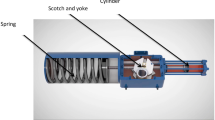Abstract
With a long time goal of detecting signs of potential machine failure, we demonstrate a proof-of-principle multiplexed, multichannel, inductive pulse sensor based on resonant frequency division multiplexing for high throughput detection of micro-scale metallic debris in lubricants. In the four-channel sensor, each sensing coil is connected to a specific external capacitance to form a parallel LC circuit that has a unique resonant frequency. Only one combined sinusoidal excitation signal consisting of four frequencies components that are close to the 4 sensing channels’ resonant frequencies was applied to the sensor, and only one combined voltage response was measured. Because each sensing channel exhibited a peak amplitude at its resonant frequency, the signals for each individual channel were recovered from the combined response by taking the spectrum components at each resonant frequency with an improved signal-to-noise ratio. Inductance change for each channel was then calculated from signals of individual channels. Testing results show that the use of resonant frequency division multiplexing allows simultaneous detection of debris in lubricants using only one set of detection electronics; for the four-channel sensor, there is a 300 % increase in throughput. The resonant frequency division multiplexing concept can be potentially applied to a multichannel oil debris sensor with a large number of sensing channels to achieve a very high throughput, which is necessary for online health monitoring of rotating and reciprocal mechanical components.






Similar content being viewed by others
References
Tucker, J.E., Galie, T.R., Schultz, A., Lu, C., Tankersley, L.L., Sebok, T., Howard, P.L.: LASERNET fines optical wear debris monitor: a Navy shipboard evaluation of CBM enabling technology. 54th Machine Failure Prevention Technology Proceedings (2000)
Edmonds, J., Resner, M.S., Shkarlet, K.: Detection of precursor wear debris in lubrication systems IEEE Aerospace Conference Proceeding 6, 73–77 (2000)
Flanagan, I.M., Jordan, J.R., Whittington, H.W.: An inductive method for estimating the composition and size of metal particle. Meas. Sci. Technol. 1, 381–394 (1999)
Flynn, B.W., Whittington, H.W.: Improved transducer design for machine wear debris monitoring. Electron. Lett. 31, 177–179 (1995)
MetalSCAN User’s Manual—Early Failure Detection for Rotating Equipment 2002 GASTOPS Inc.
Dickert, A.D., Johnson, E.L., Kirkpatrick, J.F., Hawn, K.A.: Oil monitor with magnetic field. US Patent 5,262,732 (1993)
Du, L., Zhe, J., Carletta, J.E., Veillette, R., Choy, F.: Real-time monitoring of wear debris in lubrication oil using a microfluidic inductive coulter counting device. Microfluid. Nanofluidics 9, 1241–1245 (2010)
Appleby, M., Choy, F.K.: Oil debris and viscosity monitoring using ultrasonic and capacitance/inductance measurements. Lubr. Sci. (2013). doi:10.1002/ls.1221
Du, L., Zhe, J.: An integrated ultrasonic–inductive pulse sensor for wear debris detection. Smart Mater. Struct. (2013). doi:10.1088/0964-1726/22/2/025003
Iwai, Y., Honda, T., Miyajima, T., Yoshinaga, S., Higashi, M., Fuwa, Y.: Quantitative estimation of wear amounts by real time measurement of wear debris in lubricating oil. Tribol. Int. 43, 388–394 (2010)
Fan, H.B., Zhang, Y.T., Ren, G.Q., Li, Z.N.: Experimental study of an on-line monitoring sensor for wear particles in oil. Tribology 30, 338–343 (2010)
Du, L., Zhe, J.: On-line wear debris detection in lubricating oil for condition based health monitoring of rotary machinery. Recent Pat. Electr. Eng. 4, 1–9 (2011)
Du, L., Zhe, J.: A high throughput inductive pulse sensor for online oil debris monitoring. Tribol. Int. 44, 175–179 (2010)
Cartwright, K.V., Joseph, E., Kaminsky, E.J.: Finding the exact maximum impedance resonant frequency of a practical parallel resonant circuit without calculus. Technol. Interface Int. J. 1, 26–34 (2010)
APPLICATION NOTE AN014: Understanding FFT windows. http://www.physik.uni-wuerzburg.de/~praktiku/Anleitung/Fremde/ANO14.pdf (2003). Accessed 29 March 2013
Dziczkowski, L.: Effect of eddy current frequency on measuring properties of devices used in non-destructive measurements of non-ferromagnetic metal plates. Arch. Mater. Sci. Eng. 32, 77–84 (2008)
Jagtiani, A.V., Carletta, J.E., Zhe, J.: A microfluidic multichannel resistive pulse sensor using frequency division multiplexing for high throughput counting of micro particles. J. Micromech. Microeng. 21, 065004 (2011)
Du, L., Zhe, J.: Parallel sensing of metallic wear debris in lubricants using undersampling data processing. Tribol. Int. 53, 28–34 (2012)
Du, L., Zhu, X.L., Han, Y., Zhao, L., Zhe, J.: Improving sensitivity of an inductive pulse sensor for detection of metallic wear debris in lubricants using parallel LC resonance method. Meas. Sci. Technol. (2013). doi:10.1088/0957-0233/24/7/075106
Sanders, P.G., Xu, N., Dalka, T.M., Maricq, M.M.: Airborne brake wear debris: size distributions, composition, and a comparison of dynamometer and vehicle tests. Environ. Sci. Technol. 37, 4060–4069 (2003)
Iijima, A., Sato, K., Yano, K., Tago, H., Kato, M., Kimura, H., Furuta, N.: Particle size and composition distribution analysis of automotive brake abrasion dusts for the evaluation of antimony sources of airborne particulate matter. Atmos. Environ. 41, 4908–4919 (2007)
Geller, M.D., Sardar, S.B., Phuleria, H., Philip, M., Sioutas, C.: Measurements of particle number and mass concentrations and size distributions in a tunnel environment. Environ. Sci. Technol. 39, 8653–8663 (2005)
Kukutschová, J., Roubíček, V., Mašláň, M., Jančík, D., Slovák, V., Malachová, K., Filip, P.: Wear performance and wear debris of semimetallic automotive brake materials. Wear 268, 86–93 (2010)
Acknowledgments
This article is based upon work supported by the National Science Foundation under Grant No. CMMI-0968736. Y. Han acknowledges partial support from National Natural Science Foundation of China via an Overseas Outstanding Young Scientist Award (#51128601). The authors also wish to thank Prof. L. Zhao at Xi’an Jiaotong University for valuable discussions.
Author information
Authors and Affiliations
Corresponding author
Rights and permissions
About this article
Cite this article
Du, L., Zhu, X., Han, Y. et al. High Throughput Wear Debris Detection in Lubricants Using a Resonance Frequency Division Multiplexed Sensor. Tribol Lett 51, 453–460 (2013). https://doi.org/10.1007/s11249-013-0179-x
Received:
Accepted:
Published:
Issue Date:
DOI: https://doi.org/10.1007/s11249-013-0179-x




